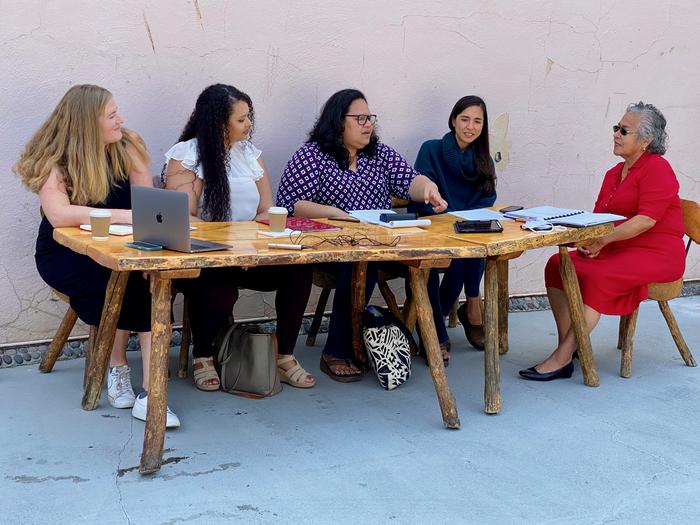Heavy wildfire smoke drifting from Canada to U.S. cities hundreds of miles away is a stark reminder that no community is immune from climate change-fueled hazards. A Stanford-led study published recently in Environmental Research Letters provides a blueprint for empowering people in frontline communities – those that experience the “first and worst” consequences of climate change – to better understand and deal with wildfire smoke, extreme heat, and other hazards.

Credit: Tom Casciato
Heavy wildfire smoke drifting from Canada to U.S. cities hundreds of miles away is a stark reminder that no community is immune from climate change-fueled hazards. A Stanford-led study published recently in Environmental Research Letters provides a blueprint for empowering people in frontline communities – those that experience the “first and worst” consequences of climate change – to better understand and deal with wildfire smoke, extreme heat, and other hazards.
The research – done in four predominantly low-income, non-English-speaking San Francisco Bay Area communities – details ways for frontline communities to gather relevant data through surveys and instruments that monitor air quality, temperature, and participant sleep health, and how to improve outcomes through various interventions.
Below, lead author Natalie Herbert, senior author Gabrielle Wong-Parodi and coauthor Cade Cannedydiscuss the pilot study’s implications for policymaking, community-led science, and more. Herbert is a research scientist in the department of Earth system science at the Stanford Doerr School of Sustainability, Wong-Parodi is an assistant professor of Earth system science and a center fellow at the Stanford Woods Institute for the Environment. Cannedy is a program manager at Climate Resilient Communities and a Stanford graduate.
How have frontline communities suffered disproportionately from wildfire smoke, extreme heat, and other climate hazards?
Cannedy: In the communities we studied, housing is often very old or in poor condition. This allows smoke, heat, and other hazards to penetrate the home. Also, the impact of these events is often cumulative. For example, wildfire smoke can have greater consequences for your health if you already have asthma from growing up in a chronically pollution burdened community like those in our study area.
What are some key interventions frontline communities can employ to deal with wildfire smoke, extreme heat, and other climate hazards?
Herbert: We found communities are already acting to protect their health from climate hazards. For example, they’re wearing masks and staying inside during smoke and heat. Yet there are opportunities for more interventions that provide additional protection, whether from public health agencies, weatherization assistance programs, or funders who support the work of our community partners. For wildfire smoke, we want to increase the number of households with better weatherization to reduce infiltration, who have and use air cleaners with HEPA filters, and who wear better masks like N95s when they’re outside.
Why should policymakers care about your pilot study?
Herbert: We learned through our pilot that the programs policymakers might wish to deploy – such as improved improving weatherization and increasing access to air purifiers – could have unintended consequences for low-income communities. Weatherization in rental units could cause landlords to increase rents, and air purifiers won’t get used if people cannot afford the associated power bill. Renter protections and outreach from low-income home energy assistance programs can help.
Wong-Parodi: Our pilot highlights a key insight for policymakers: the reason many frontline communities are exposed to climate hazards stems from structural and institutional systems that create situations where some people have been marginalized and have fewer resources. It’s important to acknowledge we have little or no information about how people in these communities are exposed, or what they are thinking, doing, and feeling in response to these threats. This information is key to developing programs and policies that can best and appropriately meet the needs of frontline communities.
What are some of the important lessons learned from this pilot study, and how might they be incorporated into similar studies?
Wong-Parodi: Our pilot would not have been successful without our community partners and community ambassadors. They reached out to their networks of friends, families, and neighbors to enroll participants. They were key in helping us to explain the study and its benefits, as well as allaying concerns.
Cannedy: Many people want to make actions accessible, but often don’t consider the equity implications. For example, having people download a smartphone app might be a great, low cost intervention for users with a lot of resources and technical expertise. But for folks who are already experiencing the worst consequences of climate change, that might not be the best solution.
The study was funded by Stanford Impact Labs, the Stanford Center for Population Health Sciences, the United States Parcel Service Endowment Fund at Stanford, the US Environmental Protection Agency, and the National Science Foundation.
Additional coauthors affiliated with Stanford include Jinpu Cao, a PhD student in civil and environmental engineering; Stephanie Fischer, a PhD student in Earth system science; Sergio Sanchez Lopez, a PhD student in the Emmett Interdisciplinary Program in Environment and Resources (E-IPER);Derek Ouyang, a research manager in the Regulation, Evaluation, and Governance Lab of Stanford Law School; Jenny Suckale, an assistant professor of geophysics and center fellow, by courtesy, at the Stanford Woods Institute for the Environment; and Zhihao Zhang, a graduate student researcher in the department of energy science and engineering. Coauthors also include researchers from Climate Resilient Communities, RTI International, Sonoma Technology, and El Concilio of San Mateo County.
Journal
Environmental Research Letters
DOI
10.1088/1748-9326/acddf9
Article Title
Improving adaptation to wildfire smoke and extreme heat in frontline communities: evidence from a community-engaged pilot study in the San Francisco Bay Area
Article Publication Date
26-Jun-2023




